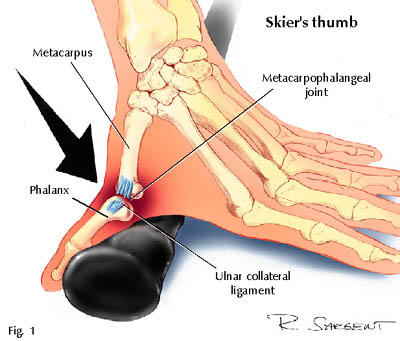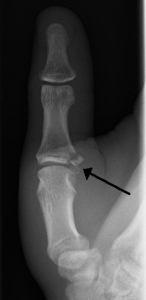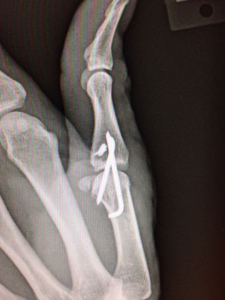 A common sports injury seen in the 1980’s was nicknamed “skier’s thumb” because skiers trying to brace for a fall would land with outstretched hands onto poorly designed ski pole grips and injure their hands. With time, pole grips have improved, thus decreasing the incidence of this injury among skiers. But anyone falling onto an outstretched hand is at risk for this thumb injury. These days, snowboarders and mountain bikers are also commonly sustaining this injury. The key to avoiding a skier’s thumb injury is to avoid falling on an outstretched hand by trying to remember in the traumatic moment of a fall to tuck the arms close to the body and rolling, rather than landing on an outstretched hand.
A common sports injury seen in the 1980’s was nicknamed “skier’s thumb” because skiers trying to brace for a fall would land with outstretched hands onto poorly designed ski pole grips and injure their hands. With time, pole grips have improved, thus decreasing the incidence of this injury among skiers. But anyone falling onto an outstretched hand is at risk for this thumb injury. These days, snowboarders and mountain bikers are also commonly sustaining this injury. The key to avoiding a skier’s thumb injury is to avoid falling on an outstretched hand by trying to remember in the traumatic moment of a fall to tuck the arms close to the body and rolling, rather than landing on an outstretched hand.
Cause
Skier’s thumb is caused by rupture of the ulnar collateral ligament (UCL) at the base of the thumb. The UCL supports the base of the thumb providing stability for pinching and gripping. The UCL attaches the 1st metacarpal bone to the proximal phalanx bone at the base of the thumb. Any force which drives the thumb away from the other fingers may rupture this very important stabilizing ligament. A falling skier may land with their pole between the thumb and index fingers rupturing the UCL as the ski pole forces the thumb away from the index finger. Similarly, a falling mountain biker or snowboarder may impact the ground or snow with his or her outstretched hand, tearing the UCL as the ground or snow forces the thumb and index fingers apart.
Regardless of the cause of injury, the UCL typically tears away from its attachment to bone at the base of the thumb. When this occurs, a unique phenomenon called a Stener lesion occurs in which the ligament is forced away from its normal attachment by a large tendon called the adductor tendon. Since the ligament has been completely torn and pushed away from its normal anchored position, it cannot heal properly. When this occurs, surgery is required to return the ligament to its normal anatomical position. Otherwise, permanent loss of thumb stability and pinch strength may result. In some cases, skier’s thumb injuries can be only partial ligament tears and often heal successfully with 4-6 weeks of thumb immobilization in a cast.
Signs and Symptoms
Symptoms of skier’s thumb include pain, instability of the metacarpal phalangeal (MCP) joint of the thumb and a very weakened or absent ability to pinch. The severity of the symptoms is related to the extent of the initial tear of the UCL or how long the injury has been allowed to progress. Characteristic signs of acute injuries include hearing a pop when the injury occurs, pain at the base of the thumb, severe swelling and bruising around the pad at the base of the thumb (thenar eminence) and especially over the MCP joint of the thumb. Physical examination of the thumb demonstrates instability of the MCP joint of the thumb compared to the uninjured side, inability to oppose the thumb and weakened pinch strength.
Diagnosis
 Often, the diagnosis of a complete or partially torn thumb ligament is made by simply examining the thumb. Tenderness over the UCL, laxity of the ligament compared to the other thumb (if not also torn), weakened pinch strength, inability to oppose the thumb, swelling and bruising are all diagnostic exam findings of a skier’s thumb injury. The experienced clinician can often tell the difference between a partial and complete tear. However, in some cases of a complete tear, it can be difficult to tell because the aponeurosis of the adductor pollicis muscle may be trapped between the bones of the MCP joint and the torn ligament, which can be very misleading and make the MCP joint feel somewhat stable on clinical exam. This occurrence is called a Stener lesion and when it happens, inadequate healing of the ligament tear will occur if it is not repaired. An MRI is extremely helpful in determining if there is a Stener lesion, as well as the position of the torn UCL and it can also show partial ruptures and cartilage damage to the MCP joint. Dr. Viola prefers an MRI on all skier’s thumb injuries to help sort this out. Xrays are also performed in the clinic to rule out the possibility of an avulsion fracture of the proximal phalanx where the UCL inserts at the bone.
Often, the diagnosis of a complete or partially torn thumb ligament is made by simply examining the thumb. Tenderness over the UCL, laxity of the ligament compared to the other thumb (if not also torn), weakened pinch strength, inability to oppose the thumb, swelling and bruising are all diagnostic exam findings of a skier’s thumb injury. The experienced clinician can often tell the difference between a partial and complete tear. However, in some cases of a complete tear, it can be difficult to tell because the aponeurosis of the adductor pollicis muscle may be trapped between the bones of the MCP joint and the torn ligament, which can be very misleading and make the MCP joint feel somewhat stable on clinical exam. This occurrence is called a Stener lesion and when it happens, inadequate healing of the ligament tear will occur if it is not repaired. An MRI is extremely helpful in determining if there is a Stener lesion, as well as the position of the torn UCL and it can also show partial ruptures and cartilage damage to the MCP joint. Dr. Viola prefers an MRI on all skier’s thumb injuries to help sort this out. Xrays are also performed in the clinic to rule out the possibility of an avulsion fracture of the proximal phalanx where the UCL inserts at the bone.
Treatment
The UCL is an important stabilizer of the thumb and any instability resulting from disruption of the UCL profoundly impairs the overall function of the involved hand. Because of this, it is critical that skier’s thumb injuries receive appropriate immediate attention and treatment. Otherwise, severe thumb arthritis, weakness and impairment are possible negative long-term outcomes of an untreated skier’s thumb.
Dr. Viola’s surgical approach to repairing the ruptured ligament is to reattach it to its normal anatomic position at the base of the thumb using a bone anchor. If there is an avulsion fracture, as in the x-ray above, screw fixation is necessary to repair the fracture, thus also stabilizing the ligament. Once anchored back down to the bone, the UCL is now in the proper position to heal completely over the next 12 weeks. The ligament at the base of the thumb needs approximately six weeks of no motion in order to heal properly.

 Dr. Viola’s treatment options to immobilize the thumb include: thumb-spica casting or splinting or pinning (internal cast) the MCP joint for six weeks. When casting or splinting and immobilization is not an option for someone for six weeks, Dr. Viola pins the joint, which serves as an internal cast. This does require a second surgery to remove the pins, but for the six weeks during that time, the patient is virtually unlimited in what activities they can do: biking, pro football, lifting, gripping, work, etc.
Dr. Viola’s treatment options to immobilize the thumb include: thumb-spica casting or splinting or pinning (internal cast) the MCP joint for six weeks. When casting or splinting and immobilization is not an option for someone for six weeks, Dr. Viola pins the joint, which serves as an internal cast. This does require a second surgery to remove the pins, but for the six weeks during that time, the patient is virtually unlimited in what activities they can do: biking, pro football, lifting, gripping, work, etc.
Your options are determined after a detailed discussion about your activities of daily living, work and sports. At six weeks post-op, an aggressive hand therapy regiment is begun which includes full active and passive range of motion and a gradual return to activities of daily living, heavy lifting and gripping. At 12 weeks post-op, there are no restrictions placed on stressing the thumb, ie rock climbing and extremely heavy use. If only a partial UCL tear exists, 4-6 weeks of thumb immobilization is necessary to heal the ligament.

